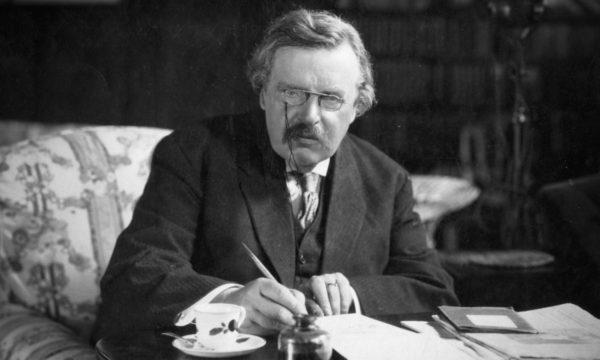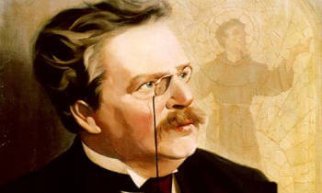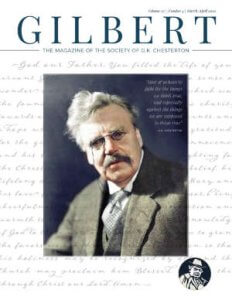While on a lecture tour of England in 1904, Chesterton met one of the most important people in his life: Father John O’Connor, a Catholic priest who became a lifelong friend and inspiration. It was Father O’Connor who opened Chesterton’s eyes to the Catholic Faith in a way he had never considered and patiently accompanied on the spiritual pilgrimage that would follow. But he also became the basis for Chesterton’s greatest fictional character, and one of the greatest characters in all of detective fiction: Father Brown.
It all started with a friendly conversation about an article Chesterton was proposing to write about “some rather sordid social questions of vice and crime.” Father O’Connor politely suggested that Chesterton was going in the wrong direction with his conclusion, and to demonstrate his point, the priest revealed “certain facts he knew about certain perverted practices” that jolted Chesterton, who “had not imagined that the world could hold such horrors.” Later in the day Chesterton and Father O’Connor were talking to some Cambridge undergraduates and got involved in a very deep and lively discussion about philosophy. After Father O’Connor excused himself, the two college students expressed their admiration for the priest’s keen intellect but ultimately dismissed him as no doubt being insulated and naïve about the real world. Chesterton says he almost laughed out loud, for it was the priest who knew more about real evil and the real world than the two Cambridge men, who in comparison knew about as much as “two babies in the same perambulator.”
The incident served as the initial inspiration for a series of mysteries featuring a priest-sleuth whose strength was twofold. One, he could solve crimes because he could get inside not only the criminal mind but the criminal heart. Two, the criminals (and everybody else) would not suspect him to suspect them because he seemed so common and naïve. His two-fold strength, in other words, was wisdom and innocence.
Chesterton’s first collection of Father Brown stories, The Innocence of Father Brown, appeared in 1911 (all had previously been published in the United States in The Saturday Evening Post). Ellery Queen called it “the miracle book of 1911.” Chesterton had done something revolutionary in detective fiction, which at that time was dominated not only by Sherlock Holmes, but by a myriad of poor imitations trying to outdo one another with ever more baffling crimes and convoluted puzzles. Chesterton favored the cozy mystery, the domestic murder, with a millionaire usually performing the important service of being the murder victim and the scope of the investigation narrowed to limited time, limited space, and a limited number of suspects, with all the clues revealed to the reader as well as to the detective. As a fan of detective fiction himself, he knew that the reader enjoyed being fooled, but being fooled fairly. Not only did he help establish the rules of fair play in the genre, but his emphasis on motive and character freed detective fiction from the copycat techniques of the rivals of Sherlock Holmes. The leading mystery writers of his day quickly embraced this new style of murder mystery. They began writing stories of domestic crimes with human motives, with a limited list of suspects, with obvious (though well-disguised) clues, and with an unlikely detective who solves his puzzles without relying on superhuman knowledge or intelligence. Indeed, whenever you think of the great detectives of mystery fiction’s golden age-Hercule Poirot, Lord Peter Wimsey, Miss Marple, Ellery Queen, Philo Vance, or Nero Wolfe-remember their parentage. Remember that they had a father. His name was Father Brown.
And there is another famous detective who was clearly inspired by Father Brown. Like Father Brown, he was slightly comical and improbable, unassuming, unthreatening, never taken seriously by the guilty party, but always knowing much more than he let on. I’m speaking of course, of TV’s Columbo.
The first Father Brown story remains one of the most famous and most reprinted: The Blue Cross. In it, a master criminal, the great Flambeau, pretends to be a priest and tries to steal a valuable cross. Father Brown exposes Flambeau as a fraud when the false priest attacks reason. A real priest, says Father Brown, would defend reason because “Alone on earth, the Church affirms that God himself is bound by reason.” Apparently this idea was too shocking for Hollywood. In the film version, starring Alec Guinness as Father Brown and Peter Finch as Flambeau, the fake priest gives himself away by ordering a ham sandwich on Friday.
In one of the most interesting twists in all of detective fiction, Flambeau goes from the role of archenemy in the first few stories to becoming a detective himself and serving as Father Brown’s sidekick in the later stories. Perhaps it was a foreshadowing of the author’s relationship with the real priest. It was long after Flambeau and Father Brown joined forces, after almost half the Father Brown stories were written, that Chesterton officially joined forces with the Real Father Brown. It was in 1922 that the Father John O’Connor received G.K. Chesterton into the Catholic Church.





